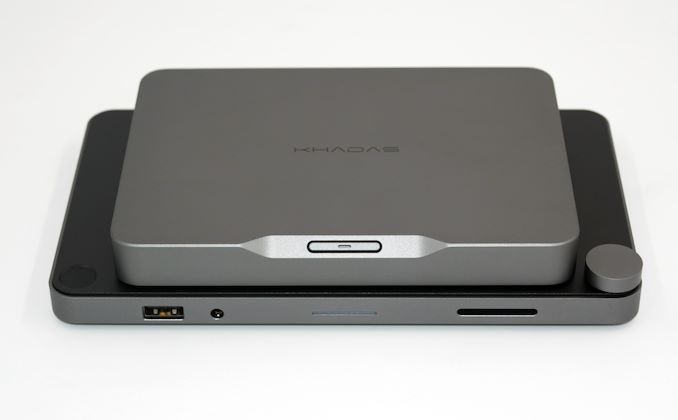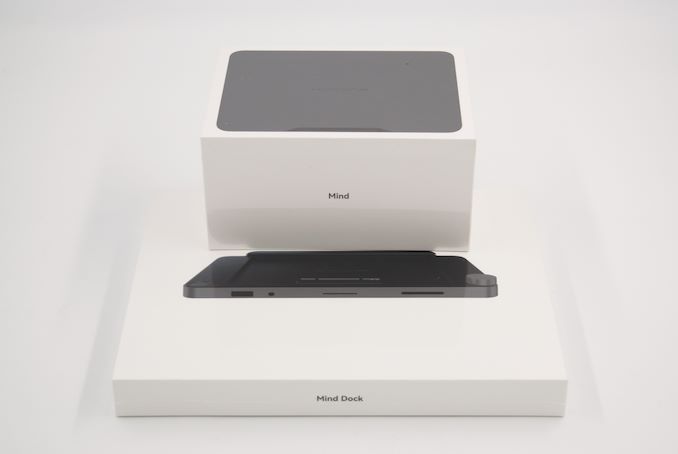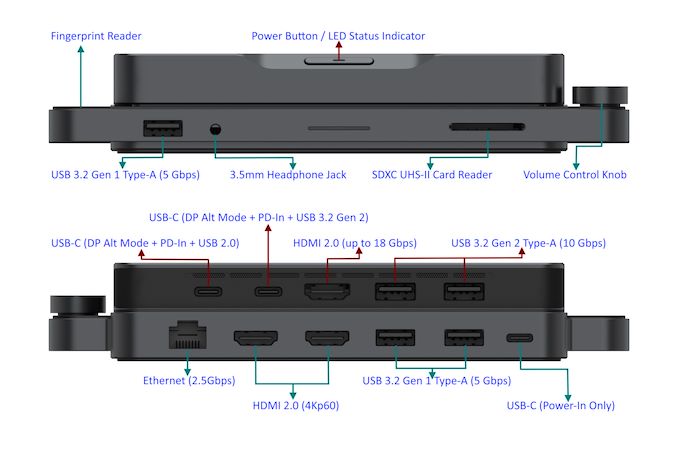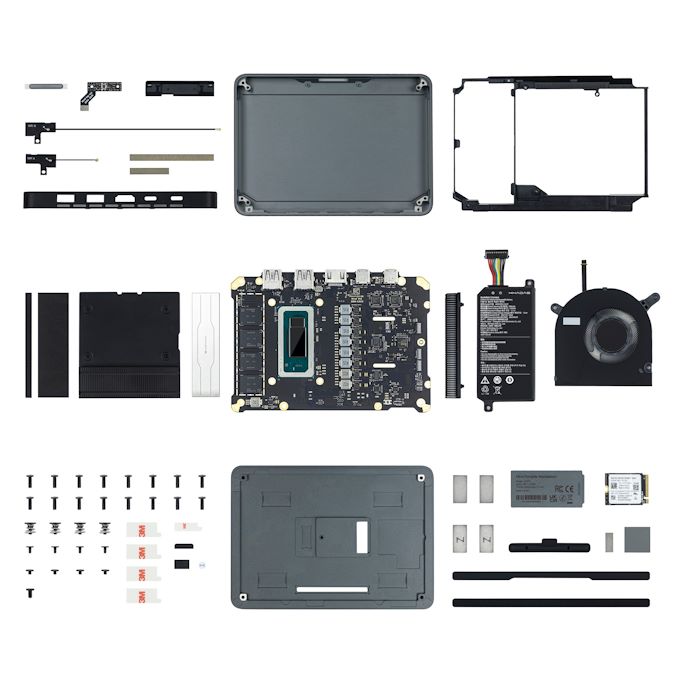Khadas Mind Premium Review: Raptor Lake-P in a Modular Portable Workstation
by Ganesh T S on September 14, 2023 8:00 AM EST- Posted in
- Systems
- Intel
- Mini-PC
- Raptor Lake-P
- Khadas

Khadas is a well-known vendor in the ARM-based single-board computer (SBC) circles with boards based on Rockchip and Amlogic SoCs. Recently, the company made its first foray into the small form-factor x86 PC space with a rather unique product family - the Khadas Mind. Unlike regular mini-PCs, the Mind is actually an ecosystem of products created with the aim of bringing a portable modular workstation to the market. Instead of relying on Thunderbolt to achieve this vision, the company has created a proprietary Mind Link connector and interface with an intent to produce a more close-knit set of products.
The main processing unit in the ecosystem is the Khadas Mind, which comes with either an Intel Core i7-1360P (Mind Premium) or an Intel Core i5-1340P (Mind Standard). Equipped with the Mind Link Connector, it can interface to a variety of peripherals such as the Mind Dock and Mind Graphics. While the former provides additional I/Os, the latter is a full-featured eGPU enclosure with a variety of ports. The main unit also includes a small battery that allows the unit to be seamlessly 'hot-plugged' into different peripherals, similar to a notebook.
Khadas sent across the Mind Premium along with the Mind Dock to provide us with an introduction to the Mind ecosystem. This review explores the performance and product experience delivered by Raptor Lake-P in an unusual package.
Introduction and Product Impressions
Advancements in processor architecture and semiconductor manufacturing have resulted in successful replacement of bulky tower desktops with miniaturized computing systems over the last decade. In parallel, notebooks have also become thinner, lighter, and very powerful. On the former front, many vendors are enjoying success with ultra-compact form-factor (UCFF) machines pioneered by Intel with the NUC product line. A few years back, Intel also started to introduce Compute Elements and even notebook platforms under the NUC tag in order to diversify beyond the original UCFF vision.
These compact machines have their limitations in terms of platform power dissipation. Addition of discrete GPUs is usually not possible with the UCFF form-factor, resulting in many use-cases still requiring bulky desktops. eGPU enclosures connected via Thunderbolt / USB4 have started to address this aspect. Notebook platforms have traditionally been limited in terms of supported screen sizes. For many business use-cases in particular, the keyboard and built-in screen lie unused, as the notebook is either docked to a bigger monitor or kept in storage. Some users adopt a thin-client model for their notebook, but multiple devices and the compulsory need for network connectivity may result in pain points associated with file syncing. Khadas has created the Mind product family as a solution to these problems.
The ecosystem consists of the main computing unit and a host of peripherals that interface using a proprietary Mind Link connector. The core computing unit is similar to that of an ultrabook's main board - compact, and limited in terms of I/O. However, the leeway over the unit's thickness (compared to a regular ultrabook) has enabled Khadas to equip the board with a vapor chamber-based cooling system. While the LPDDR5 RAM is soldered, the system comes with two M.2 2230 Gen4 x4 NVMe slots. Khadas doesn't sell barebones versions, but markets two different SKUs that come pre-installed with Windows 11 Home:
- Mind Premium: Core i7-1360P / 32GB of LPDDR5-5200 RAM / 1TB Gen4 x4 NVMe SSD
- Mind Standard: Core i5-1340P / 16GB of LPDDR5-5200 RAM / 512GB Gen4 x4 NVMe SSD
Khadas has plans for a large number of peripherals:
- Mind Dock: I/O expansion with additional network ports, video outputs, audio subsystem, and USB ports.
- Mind Graphics: eGPU enclosure with the NVIDIA RTX 4060Ti and additional I/O ports.for the gaming market.
- Mind Studio: Large touchscreen monitor with additional GPU for creative professionals.
- Mind xPlay: 2-in-1 tablet / notebook conversion kit (portable monitor with keyboard)
- Mind Talk: Conference room conversion kit
Currently, the company already has the Mind Dock ready to ship (it came in as part of our review package along with the Mind Premium), and the Mind Graphics is expected to ship in June 2024. The other peripherals are still in the planning stages.
The Mind Premium package comes with the main unit and USB-PD compliant Type-C adapter (up to 65W) and a braided Type-C cable along with it. A warranty card and a quick start guide are also included.
The gallery below presents the external industrial design of the main unit as well as the Mind Dock.
The main unit is a compact rectangular slab measuring 146mm x 105mm x 20mm, with a weight of 450g. The rounded edges and metal enclosure lend it a solid look and feel. Unfortunately, the core unit is rather anemic in terms of I/O. There are three display outputs - a HDMI port, and two Type-C ports. Either of the Type-C ports can be used to connect the power adapter, but they also support data transfer as detailed below. There are two USB 3.2 Gen 2 Type-A ports. The absence of USB4 / Thunderbolt 4 is a major letdown, though.
The Mind Dock provides wired networking support, a 3.5mm headphone jack, a SDXC UHS-II card slot and multiple USB 3.2 Gen 1 Type-A ports. Two HDMI 2.0 ports are also included. The Mind Dock also has a fingerprint reader and a volume control knob. Speakers are also built into the dock.
Khadas provided a full-blown teardown picture of the Mind Standard along with their press package.
The main unit is equipped with a Western Digital SN740 NVMe SSD, while the Samsung LPDDR5-5200 RAM chips are soldered. A 5.55Wh battery is also included - similar to a notebook platform. However, the battery is not meant to be used for regular operation in the absence of power input. Rather, it is meant to aid in hot-plugging and allowing the system to go to sleep without having to shut down in the absence of external power. Khadas promises up to 25 hours of standby in such scenarios.
The full specifications of the review sample (as tested) are summarized in the table below. We evaluate two configurations - one with just the Mind Premium, and another with the Mind Dock.
| Systems Specifications (as tested) |
||
| Khadas Mind Premium | Khadas Mind Premium + Mind Dock | |
| Processor | Intel Core i7-1360P Raptor Lake 4P + 8E / 16T, up to 5.0 GHz (P) up to 3.7 GHz (E) Intel 7, 18MB L2, Min / Max / Base TDP: 20W / 64W / 28W PL1 = 28W, PL2 = 64W |
Intel Core i7-1360P Raptor Lake 4P + 8E / 16T, up to 5.0 GHz (P) up to 3.7 GHz (E) Intel 7, 18MB L2, Min / Max / Base TDP: 20W / 64W / 28W PL1 = 28W, PL2 = 64W |
| Memory | 32GB LPDDR5-5200 Soldered 64-48-48-112 @ 5200 MHz 4x8 GB |
32GB LPDDR5-5200 Soldered 64-48-48-112 @ 5200 MHz 4x8 GB |
| Graphics | Intel Iris Xe Graphics (96EU @ 1.50 GHz) |
Intel Iris Xe Graphics (96EU @ 1.50 GHz) |
| Disk Drive(s) | Western Digital PC SN740 SDDQTQD-1T00 (1 TB; M.2 2230 PCIe 4.0 x4 NVMe;) (Western Digital 112L BiCS5 3D TLC NAND; SanDisk 20-82-10081 DRAM-less Controller) |
Western Digital PC SN740 SDDQTQD-1T00 (1 TB; M.2 2230 PCIe 4.0 x4 NVMe;) (Western Digital 112L BiCS5 3D TLC NAND; SanDisk 20-82-10081 DRAM-less Controller) |
| Networking | Intel Wi-Fi 6E AX211 (2x2 802.11ax - 2.4 Gbps) | Realtek RTL8156 2.5 GbE Controller (via Mind Link / USB) Intel Wi-Fi 6E AX211 (2x2 802.11ax - 2.4 Gbps) |
| Audio | Digital audio with bitstreaming support over HDMI | USB audio codec (via Mind Link / USB) (3.5mm audio jack in front) Digital audio with bitstreaming support over HDMI |
| Video | 1x HDMI 2.0 (Rear) 2x Display Port 1.4a over Type-C Alt-Mode (Rear) |
1x HDMI 2.0 (Rear on Main Unit, HDR Supported) 2x HDMI 2.0 (Rear on Dock, No HDR) 2x Display Port 1.4a over Type-C Alt-Mode (Rear on Main Unit) (max. 4 displays) |
| Miscellaneous I/O Ports | 2x USB 3.2 Gen 2 Type-A (Rear) 1x USB 3.2 Gen 2 Type-C (Rear, with DP Alt Mode and PD Input) 1x USB 2.0 Type-C (Rear, with DP Alt Mode and PD Input) |
2x USB 3.2 Gen 2 Type-A (Rear on Main Unit) 1x USB 3.2 Gen 2 Type-C (Rear on Main Unit, with DP Alt Mode and PD Input) 1x USB 2.0 Type-C (Rear on Main Unit, with DP Alt Mode and PD Input) 1x SDXC UHS-II Card Reader (Front on Dock) 1x USB 3.2 Gen 1 Type-A (Front on Dock) 2x USB 3.2 Gen 1 Type-A (Rear on Dock) 1x USB-C Power Input (Rear on Dock) |
| Operating System | Windows 11 Enterprise (22000.2360) | Windows 11 Enterprise (22000.2360) |
| Pricing | US $1099 (as configured, with Windows 11 Home OS) | US $1278 (as configured, with Windows 11 Home OS) |
| Full Specifications | Khadas Mnd Specifications | Khadas Mnd Specifications |
In the next section, we take a look at the system setup and follow it up with a detailed platform analysis.




















20 Comments
View All Comments
wr3zzz - Thursday, September 14, 2023 - link
This is what Intel NUC should've been. 450 grams, sleek look, magnetic snap-on interface for compatible docking station, e-GPU, portable and fixed displays.hubick - Thursday, September 14, 2023 - link
Thunderbolt eGPU's and stuff are already niche enough, and being invested in that ecosystem, the proprietary connector is a deal breaker for me. I fully lost interest when I saw the RAM was soldered. It's a shame they went proprietary, cuz this looks neat.meacupla - Thursday, September 14, 2023 - link
It has 32GB of LPDDR5 5200. How much more do you want?Samus - Friday, September 15, 2023 - link
Seriously, and there aren't really any options out there for high speed low profile memory. I'd take soldered LPDDR5 over any regular DDR4\5 socket, just make sure you get 16GB-32GB depending on your future use case. Nobody is going to keep running this thing 10 years from now when 32GB won't suffice.Meanwhile most PC's ship with 16GB and I still see 8GB in laptops, which has been pretty standard for...10 years.
PeachNCream - Thursday, September 14, 2023 - link
This was absolutely sent to Future for the free advertising that an article about it would generate AND it's a pretty stupid idea since, well laptop and desktop workstations both exist and offer either more flexibility and the same relative compute power (typically with a larger company's backing) OR more compute power for the same cost. The gimmicky form factor is only a gimmick and nothing more.ganeshts - Thursday, September 14, 2023 - link
'Product sent for free advertising' - The way PR works is that the agency is tasked with promoting product awareness. 'Advertising' - at least in the TV / Internet age - refers to something that focuses purely on the positives of a product and pushes viewers / readers to go out and purchase the product. It is always a good idea to approach any article or review with wariness, but it looks like you want to see malice where there is none.PR agencies and reps pitch countless products for review, and we don't have enough resources or man-hours to justify an AnandTech-level review for each of those pitched products. Personally, I take up a product for review only if it offers something new or novel. There is absolutely no doubt that the Mind Family of products is something that has not been attempted successfully before. It may appear gimmicky, but the engineering effort towards creating a 256 Gbps external peripheral interface is definitely not something to be viewed with derision (which is what your post comes across as).
Every time a company tries to create something new with focus on multiple product categories - 'a jack of all trades', there is always going to be a 'master of one' competitor. The question is whether the new product can evolve over multiple generations to re-frame the paradigm. (I would take the example of an iPod that appeared when there were other MP3 players in the market too. In fact, other than branding and industrial design, it wasn't offering too much novelty. But, that slowly metamorphosed into the iPhone juggernaut over a 15 - 20 year timeframe).
The reason I am typing out this lengthy response is not because I have a vested interest in promoting the Mind family. In fact, you can see we do not even carry a link to the crowdfunding site where Khadas is currently selling the system before moving it to the Khadas shop / Amazon. Rather, I want to make sure readers are able to see the big picture as well as detailed specifics on where Khadas should be improving. I would say that in the last 5 - 7 years, this mini-PC is probably the one that I have spent the most time in reviewing - just because it is very different from what is usually put out in this space. And, I would love readers to understand that.
Coming back to the 'advertising' claims - did you even read the concluding section? Khadas actually links to various reviews from their crowfunding campaign. I suspect it is unlikely they are going to link to our review. We have always aimed to present a balanced view of products and its capabilities. As it stands today, Khadas still has much to prove. That said, there is plenty of potential and the Mind Link interface is certainly praiseworthy for its capabilities (it is better than external OCuLink and Thunderbolt 5 from a technical viewpoint).
meacupla - Thursday, September 14, 2023 - link
When do you expect to see the GPU and monitor docks become available?When they do, are you going to review those?
ganeshts - Friday, September 15, 2023 - link
The GPU should be available in June 2024. There is no ETA yet for the other peripherals.As for review, it depends on Khadas. If they offer, I will definitely take it up [ as we do have a concrete idea of how eGPU enclosures need to be evaluated - https://www.anandtech.com/show/13944 ]
meacupla - Friday, September 15, 2023 - link
oof, that is a rough launch window for the GPU dock. They should have stuck to an already established connector, like occulink.Samus - Friday, September 15, 2023 - link
Probably not worth considering the i7-1360P. It is (in real world performance) virtually identical to the i5-1340P.I have two notebooks with an i5-1240P and i7-1260P respectively and you literally would never be able to tell them apart in any task. The only difference as far as I can tell is slightly higher base and boost clock, and the i7 has more L3 cache that doesn't seem to mean anything in most applications. The GPU core has an additional core (so 96 EU's over 80 EU's in the i5.) They are otherwise identical CPU's with the same P and E cores.